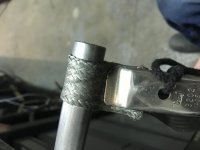The Dude
Hot Rolled
- Joined
- Oct 19, 2010
- Location
- Portland, OR
I'm designing a manual weld fixture where the welder will rotate a "bolt head welded to the side of a nut". It will be pre-tacked and then clamped into a rotating fixture. The current design is to use about a 1" shaft that is mounted to the rotating fixture (co-linear of course to make the rotation without wobble) and it will travel through a bushing/mount with a handle on the opposite side. Just to help out, they'll likely have a saddle for the torch to more easily keep it in position.
I'm not an expert on weld grounding and wondering if I can pass the ground though the rotating shaft, maybe if the shaft is steel and I press a brass bushing into the support? I would like to avoid a special rotating ground that would get in the way of the operator being able to rotate the assembly while welding. Ultimately, if volume increases, we may add a motor drive/belt to rotate it via foot pedal but it will be starting out with manual rotation.
If you look at the photo, ignore the little piece off to the right.
Any help is appreciated.
Thanks,
The Dude

I'm not an expert on weld grounding and wondering if I can pass the ground though the rotating shaft, maybe if the shaft is steel and I press a brass bushing into the support? I would like to avoid a special rotating ground that would get in the way of the operator being able to rotate the assembly while welding. Ultimately, if volume increases, we may add a motor drive/belt to rotate it via foot pedal but it will be starting out with manual rotation.
If you look at the photo, ignore the little piece off to the right.
Any help is appreciated.
Thanks,
The Dude





